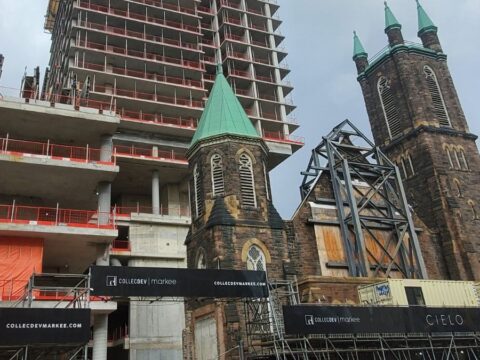There’s a lot of sunlight in 40 Oaks, courtesy of a lot of windows. You can sit in front of one of those many windows and bask in the sunshine while watching the people go by. This is remarkable for several reasons. First, all of those windows are brand new, as is the rest of 40 Oak St., home of the Toronto Christian Resource Centre (CRC) in Regent Park, a longstanding mission supported by the United Church.
The new building provides both affordable housing and a host of new community programs. And 40 Oaks is part of a larger redevelopment of Toronto’s Regent Park neighbourhood, Canada’s largest and oldest public housing project. The ongoing revitalization effort is bringing people out of their homes and into the community.
You may unsubscribe from any of our newsletters at any time.
Regent Park was not always pedestrian friendly. In fact, the low-income neighbourhood in Toronto’s east downtown was notoriously dangerous and isolated. Conceived as a “garden city” when it was built in the late 1940s, the complex felt hived-off from the rest of downtown and quickly deteriorated. There was little through traffic, few commercial enterprises and scarce reason for residents to interact with each other. With no eyes on the street, Regent Park became the kind of place you wouldn’t want to walk in after dark.
Today’s Regent Park is home to 10,000 residents who speak at least 90 different languages. According to 2006 census figures, 73 percent of the adult population is underemployed, and 100 percent of residents live in poverty, including more than 5,000 youth and children.
Regent Park dwellers have been advocating for change in the neighbourhood since the mid-1990s. Debra Dineen, the executive director of 40 Oaks, was one of the residents on the revitalization committee, which met every two weeks for five years. “We were either committed or committable,” says Dineen with a laugh. “We’re still trying to figure that out.”
In 2000, with the formation of the Toronto Community Housing Corporation, the City of Toronto made a plan to revitalize the area over 15 years. All 2,083 units of housing would be demolished, streets would be opened and businesses brought in. Further, the neighbourhood would have a mix of affordable housing and market-priced properties. The redevelopment project is now in the second of its six phases.
The Toronto Christian Resource Centre was involved with this revitalization from the first phase, which was especially important when it came to the mixing of different income levels. Regent Park is now the proud owner of a bank, a grocery store and even a Tim Hortons, but none of these places function as real community-building tools. As Dineen points out, people do go to Tim Hortons, and they shop and they hold doors open for one another, but no one tends to develop friendships while standing in line for coffee. What the neighbourhood needed was a space where all the members of the community could feel welcomed, valued and respected. Enter 40 Oaks.
The new building wears multiple hats. First, it’s home to 87 new units of desperately needed affordable housing. While the wider Regent Park revitalization effort is committed to replacing all the units that will be demolished, there is still a struggle to bring in new ones. So 40 Oaks took to the sky, building apartments over top of the community program space. On the main floor, 40 Oaks houses a community food program, community gardens where residents can grow their own food, a worship space for Regent Park United and other faith groups, and community services such as assistance with food access and housing. The building itself has been constructed to LEED Silver environmental standards, including energy-efficient lighting and low-flow plumbing fixtures. From the outside, its clean and modern design looks impressive. But it is the inside, the heart of the building, that sets 40 Oaks apart.
Take, for example, the daily drop-in program, rechristened the Community Meal Program. “It’s a simple move,” says Dineen, “but what has happened is that more people are coming in for meals — we have about 200 to 300 people a day — and it’s mixed.” Slowly but surely since the program began in April, higher-income residents have started dropping by for a cup of coffee and a chat with neighbours — whomever they might be. Organizers are also seeing more mothers coming in with their kids for a hot lunch, another significant change. Many of the drop-in programs in Toronto are not places most parents would want to bring their kids, but 40 Oaks feels different. “People here get up in the morning, they have a place to go, they care about the place they go because people treat them respectfully, and then they give back,” says Dineen. It was not long before members of the Regent Park community from all income brackets were behind the counters serving the lunches.
Residents of 40 Oaks also feel the difference in this building. Joan LaFramboise, who shares a one-bedroom unit with her six pets, has lived in other Toronto Community Housing homes before. In her last place, she was afraid to sleep at night. But not at 40 Oaks. “This is a special space, because we’re safe in this community,” she says. “We’re all like family here. We all care for one another, and we try to help one another out — that’s just the way we are.”
What makes 40 Oaks special is partly the change in the physical space. The new community room is full of light, which was a conscious design choice. The CRC’s old building was dark, and many of the programs were carried out in the basement of Regent Park United. At 40 Oaks, people are brought literally into the light. Public Displays of Affection, a Toronto firm that specializes in innovative designs for projects like community housing, provided sustainable and stylish furnishings for the building. The firm used many reclaimed and recycled materials in its work, including items saved from demolished churches. So bits and pieces of old pews became part of an art piece in the main hallway, and reclaimed pews and doors became tables that community members now dine upon. Lighting fixtures and other materials from the old CRC building were also fashionably refurbished.
The United Church has deep roots in the CRC, which was founded in 1965 as an outreach mission of Rosedale United. It and other Toronto congregations contributed significant funds to build the new 40 Oaks. When members of St. James-Bond United decided to merge congregations with Fairlawn Heights United in 2005, they sold their building and were the first investors in the planned renovations for the CRC, with a donation of $1.5 million. Then Rosedale United, a thriving congregation, committed to raising $650,000. Deer Park United contributed $500,000 to the project when it closed four years ago. And the Toronto United Church Council, which owns the land, is renting to 40 Oaks for a dollar a year, an expression of the council’s support for the centre, says executive director Rev. Vince Alfano. “The board of directors felt the United Church presence in Regent Park is critical, and over the years we’ve held onto that land because of a strong sense of mission for that community, and we have found a ministry partner that is able to carry out the work that needs to be done there.”
But it’s more than financial commitments that help. The 40 Oaks project has been blessed with an army of United Church volunteers who donate their time to help make the building a home. Forty-seven of the new affordable housing units came fully furnished, down to towels, toasters and fully stocked salt and pepper shakers. It was volunteers who sought out donations of furniture and appliances, and it was volunteers who gave up a week of their Christmas vacations this year to make sure every unit was cleaned and ready to welcome its occupants. “When I think about what’s happened here,” says Dineen, “I think about the social gospel, and I think about how our call to care for people is represented here. And it wasn’t just represented over the Christmas holidays, but by people who gave money to build this building, and the folks who continue to come here on a weekly basis to serve lunches and have conversations.”
One such volunteer is Jennifer Wootton Regan, a member of Rosedale United. Her favourite stories are about the human connections at 40 Oaks. “I’ve watched a guest sit down and, with a couple of forks, teach a young Asian girl who can barely speak English how to play the drums. All of a sudden they’ve made a friendship,” she says. “And there’s nothing greater than going in as a volunteer and meeting someone new who is 30 days clean [from drugs or alcohol], and then being there for a high-five when they’re 50 days or 75 days. Seeing that change in people is really heartwarming, and you can never underestimate what giving people that support can mean.”
***
This story first appeared in The United Church Observer’s September 2012 issue with the title “40 Oaks rises.”















We’re new to the neighbourhood and can’t wait to visit